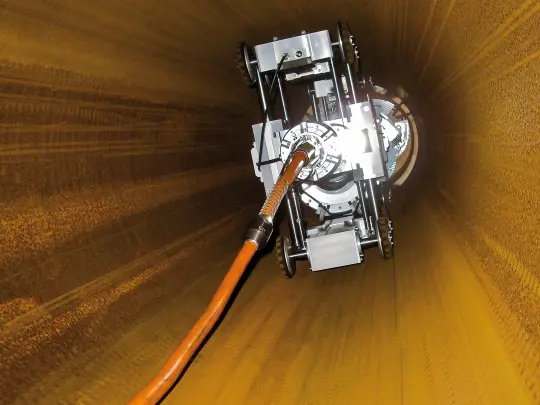All in One Line
Highly specialised ultrasonic inspection robots comb pipelines in search of leaks and corrosion. A new custom cable from HELUKABEL is their only link with the outside world.
The ultrasonic inspection robot advances at very slow speeds. It is deployed in the USA on behalf of GE Hitachi to search underground pipes centimetre by centimetre for leaks. Its finely tuned ultrasonic sensors measure the thickness of the pipe walls, and it also sends images to its human colleagues at the surface via a camera attached to its tip. It goes where humans can’t, pushing its way through the darkness, snaking around bends, making its way wherever the pipeline guides it to. An electric motor powers its wheels by way of several drive elements. Compressed air is used to push the wheels onto the inner wall of the pipeline, giving the robot sufficient grip to be able to follow the pipeline’s bends but also its vertical sections. Despite all this complexity, a single cable is its lifeline to the outside world.

CHARTING NEW TERRITORY
The highly specialised ultrasonic inspection robot that GE Hitachi uses to inspect underground pipelines was made by Inspector Systems. For more than 30 years, this company from Hesse, near Frankfurt, has been designing pipeline robots to customer specifications for inspecting, testing and processing the inside of pipeline systems. For this particular contract, the engineers from Inspector Systems wanted a single-cable solution. The cable was responsible for providing power, data and compressed air. Initially as a pilot project for the inspection robot, the scope changed to include configurations for working robots, which can seal leaks and correct bottlenecks using powerful tools. Integrating all the required functions within a single cable was new territory for the developers. But only 10 weeks after receiving the enquiry, the cable specialists were able to deliver the kilometre-long, custom cable for the ultrasonic inspection robot.
CUSTOMER-CONFIGURED CABLE
Power is supplied to the robot via copper conductors. A pair of twisted signal cables supplies power to the high-resolution camera. Data is transmitted via a BUS cable and optical fibre. The optical fibre cable was a particular challenge, because even though it is very stiff, it had to be able to wind onto drums. The engineers chose PU tubes for the compressed air supply. Like an umbilical cord, the cable is also its lifeline. If the robot breaks down, it can be pulled out of the pipeline by the cable. This is possible because the cable is reinforced by a filler material made of Kevlar which makes it tear proof. The whole thing is protected by an outer sheath made from a special polyurethane (PUR), a durable plastic. This is important because the robot must be able to operate in rough conditions. Any other material would not be able to withstand all of the edges and corners. In only a short time, HELUKABEL succeeded in developing a tailor-made cable that was able to meet all of the tough requirements and control their robots perfectly.
FOUR FOLLOW-UP PROJECTS
There are a total of eight engineers at HELUKABEL working on projects such as this one in the custom cables department. They are responsible for applications that cannot be accommodated by cables from the standard catalogue. Four additional cable models have also been designed for Inspector Systems for use with four different robotic systems.
| ROBOT | MANUFACTURER |
| The ultrasonic inspection robot measures the wall thickness of extensive underground pipeline sections and is able to detect leaks and corrosion. It is able to advance through the pipe automatically and is designed for a total working length of 300 m (984 ft). In addition to test measurements, it transmits images from one or more cameras to the surface. | Inspector Systems, based near Frankfurt, produces pipeline robots designed for inspecting, testing and processing the inside of pipeline systems. The company markets its customer-specific solutions all over the world. Its areas of application include power stations, oil refineries, gas pipelines and district heating pipes. |
| CLIENT | |
| GE Hitachi is a joint project between U.S.-based General Electric (GE) and Japan-based Hitachi. The alliance was formed in 2007 in order to pool the nuclear power activities of the two conglomerates. |
